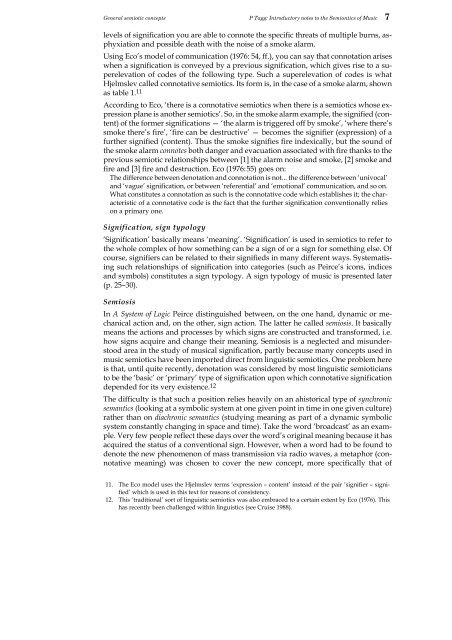Introductory notes to the Semiotics of Music - Philip Tagg's home page
Introductory notes to the Semiotics of Music - Philip Tagg's home page
Introductory notes to the Semiotics of Music - Philip Tagg's home page
Create successful ePaper yourself
Turn your PDF publications into a flip-book with our unique Google optimized e-Paper software.
General semiotic concepts P Tagg: <strong>Introduc<strong>to</strong>ry</strong> <strong>notes</strong> <strong>to</strong> <strong>the</strong> Semiontics <strong>of</strong> <strong>Music</strong> 7<br />
levels <strong>of</strong> signification you are able <strong>to</strong> connote <strong>the</strong> specific threats <strong>of</strong> multiple burns, asphyxiation<br />
and possible death with <strong>the</strong> noise <strong>of</strong> a smoke alarm.<br />
Using Eco’s model <strong>of</strong> communication (1976: 54, ff.), you can say that connotation arises<br />
when a signification is conveyed by a previous signification, which gives rise <strong>to</strong> a superelevation<br />
<strong>of</strong> codes <strong>of</strong> <strong>the</strong> following type. Such a superelevation <strong>of</strong> codes is what<br />
Hjelmslev called connotative semiotics. Its form is, in <strong>the</strong> case <strong>of</strong> a smoke alarm, shown<br />
as table 1. 11<br />
According <strong>to</strong> Eco, ‘<strong>the</strong>re is a connotative semiotics when <strong>the</strong>re is a semiotics whose expression<br />
plane is ano<strong>the</strong>r semiotics’. So, in <strong>the</strong> smoke alarm example, <strong>the</strong> signified (content)<br />
<strong>of</strong> <strong>the</strong> former significations — ‘<strong>the</strong> alarm is triggered <strong>of</strong>f by smoke’, ‘where <strong>the</strong>re’s<br />
smoke <strong>the</strong>re’s fire’, ‘fire can be destructive’ — becomes <strong>the</strong> signifier (expression) <strong>of</strong> a<br />
fur<strong>the</strong>r signified (content). Thus <strong>the</strong> smoke signifies fire indexically, but <strong>the</strong> sound <strong>of</strong><br />
<strong>the</strong> smoke alarm con<strong>notes</strong> both danger and evacuation associated with fire thanks <strong>to</strong> <strong>the</strong><br />
previous semiotic relationships between [1] <strong>the</strong> alarm noise and smoke, [2] smoke and<br />
fire and [3] fire and destruction. Eco (1976: 55) goes on:<br />
The difference between denotation and connotation is not... <strong>the</strong> difference between ‘univocal’<br />
and ‘vague’ signification, or between ‘referential’ and ‘emotional’ communication, and so on.<br />
What constitutes a connotation as such is <strong>the</strong> connotative code which establishes it; <strong>the</strong> characteristic<br />
<strong>of</strong> a connotative code is <strong>the</strong> fact that <strong>the</strong> fur<strong>the</strong>r signification conventionally relies<br />
on a primary one.<br />
Signification, sign typology<br />
‘Signification’ basically means ‘meaning’. ‘Signification’ is used in semiotics <strong>to</strong> refer <strong>to</strong><br />
<strong>the</strong> whole complex <strong>of</strong> how something can be a sign <strong>of</strong> or a sign for something else. Of<br />
course, signifiers can be related <strong>to</strong> <strong>the</strong>ir signifieds in many different ways. Systematising<br />
such relationships <strong>of</strong> signification in<strong>to</strong> categories (such as Peirce’s icons, indices<br />
and symbols) constitutes a sign typology. A sign typology <strong>of</strong> music is presented later<br />
(p. 25–30).<br />
Semiosis<br />
In A System <strong>of</strong> Logic Peirce distinguished between, on <strong>the</strong> one hand, dynamic or mechanical<br />
action and, on <strong>the</strong> o<strong>the</strong>r, sign action. The latter he called semiosis. It basically<br />
means <strong>the</strong> actions and processes by which signs are constructed and transformed, i.e.<br />
how signs acquire and change <strong>the</strong>ir meaning. Semiosis is a neglected and misunders<strong>to</strong>od<br />
area in <strong>the</strong> study <strong>of</strong> musical signification, partly because many concepts used in<br />
music semiotics have been imported direct from linguistic semiotics. One problem here<br />
is that, until quite recently, denotation was considered by most linguistic semioticians<br />
<strong>to</strong> be <strong>the</strong> ‘basic’ or ‘primary’ type <strong>of</strong> signification upon which connotative signification<br />
depended for its very existence. 12<br />
The difficulty is that such a position relies heavily on an ahis<strong>to</strong>rical type <strong>of</strong> synchronic<br />
semantics (looking at a symbolic system at one given point in time in one given culture)<br />
ra<strong>the</strong>r than on diachronic semantics (studying meaning as part <strong>of</strong> a dynamic symbolic<br />
system constantly changing in space and time). Take <strong>the</strong> word ‘broadcast’ as an example.<br />
Very few people reflect <strong>the</strong>se days over <strong>the</strong> word’s original meaning because it has<br />
acquired <strong>the</strong> status <strong>of</strong> a conventional sign. However, when a word had <strong>to</strong> be found <strong>to</strong><br />
denote <strong>the</strong> new phenomenon <strong>of</strong> mass transmission via radio waves, a metaphor (connotative<br />
meaning) was chosen <strong>to</strong> cover <strong>the</strong> new concept, more specifically that <strong>of</strong><br />
11. The Eco model uses <strong>the</strong> Hjelmslev terms ‘expression – content’ instead <strong>of</strong> <strong>the</strong> pair ‘signifier – signified’<br />
which is used in this text for reasons <strong>of</strong> consistency.<br />
12. This ‘traditional’ sort <strong>of</strong> linguistic semiotics was also embraced <strong>to</strong> a certain extent by Eco (1976). This<br />
has recently been challenged within linguistics (see Cruise 1988).














